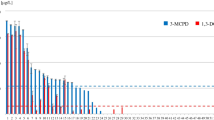Abstract
Di(2-ethylhexyl) maleate (DEHM) is a non-evaluated substance newly detected in the majority of the printed cardboard boxes used for food packaging. Concentrations in the board are often sufficient for a migration into food of around 1 mg/kg. This level was reached after storage over several months and in the absence of a functional barrier (such as a layer of aluminum). The maximum concentration determined in food was 1,500 μg/kg, even though the end of the shelf life of the product was not reached. DEHM is probably the non-reacted starting material in di(2-ethylhexyl) sulfosuccinate, which is used at concentrations of several percent as an emulsifier for water-based varnishes. A minor contribution is from recycled fibers, presumably contaminated through the same route. DEHM was absent in printing inks and almost all adhesives tested. No toxicological facts are available for DEHM. Through comparison with similar substances, the German BfR Committee for Consumer Products recommended a temporary migration limit of 50 μg/kg, whereas the Swiss Federal Office of Public Health concluded on a lower toxicity. The case shows that impurities in components used for printing cardboard may migrate at concentrations demanding substantial compliance work.





Similar content being viewed by others
References
BfR (2008) Bundesinstitut für Risikobewertung, 1. Sitzung der BfR-Kommission für Bedarfsgegenstände (Beko), Berlin, 24 Apr 2008. http://www.bfr.bund.de/cm/207/1_sitzung_der_bfr_kommission_fuer_bedarfsgegenstaende.pdf
Bradley EL, Honkalampi-Hämäläinen U, Weber A, Andersson MA, Bertaud F, Castle L, Dahlman O, Hakulinen P, Hoornstra D, Lhuguenot J-C, Mäki-Paakkanen J, Salkinoja-Salonen M, Speck DR, Severin I, Stammati A, Turco L, Zucco F, von Wright A (2008) Food Chem Toxicol 46:2498–2509
Koch HM, Bolt HM, Angerer J (2004) Arch Toxicol 78:123–130
BfR (2008) Bundesinstitut für Risikobewertung, 2. Sitzung der BfR-Kommission für Bedarfsgegenstände (Beko), Berlin, 2 Dec 2008. http://www.bfr.bund.de/cm/207/2_sitzung_der_bfr_kommission_fuer_bedarfsgegenstaende.pdf
Swiss Federal Office of Public Health, Informationsschreiben 149: DEHM in Lebensmitteln. http://www.bag.admin.ch/themen/lebensmittel/04857/index.html?
Fankhauser-Noti A, Grob K (2006) J Sep Sci 29:2365–2374
Verordnung des EDI vom 23. November 2005 über Bedarfsgegenstände. http://www.admin.ch/ch/d/sr/c817_023_21.html
Grob K, Stocker J, Colwell R. (2009) Food Control 20:476–82/483–490
Author information
Authors and Affiliations
Corresponding author
Rights and permissions
About this article
Cite this article
Fiselier, K., Rutschmann, E., McCombie, G. et al. Migration of di(2-ethylhexyl) maleate from cardboard boxes into foods. Eur Food Res Technol 230, 619–626 (2010). https://doi.org/10.1007/s00217-009-1200-3
Received:
Revised:
Accepted:
Published:
Issue Date:
DOI: https://doi.org/10.1007/s00217-009-1200-3




